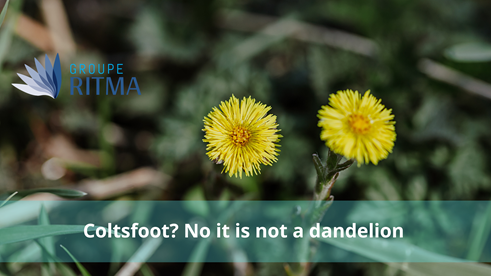
Chronicles
17 April 2023
No, it's not a dandelion, it's a coltsfoot

With its yellow flowers similar to those of the dandelion, many people confuse them. However, coltsfoot flowers before its leaves unfold. It appears in April as soon as the snow melts, while the dandelion in Quebec only flowers in May.
Called in the Middle Ages by the Romans "Filius ante patrem", meaning the "son before the father", because it has the particularity of flowering long before its leaves appear, coltsfoot, also known by the scientific name Tussilago farfara, has leaves reminiscent of a hoof in shape, hence the common name in French meaning "donkey step". They can be recognized not only by their shape, but also by their back covered with white felt.
Coltsfoot is a perennial plant that belongs to the Asteraceae family like the dandelion. This plant is native to Europe and Asia, but has been introduced to other parts of the world, such as North America, as a medicinal plant. It generally grows in moist places and is now very widespread (even invasive), especially in loamy and moist soils.
A plant that unfolds abundantly
A restocking plant, the "donkey step" often appears in disturbed soils, especially on fill land. With its dense and broad leaves, it competes with native plants and can manage to dominate a space. However, coltsfoot loves the sun and gradually disappears when trees and shrubs settle in and create shade.
Coltsfoot can reach a height of 30 to 40 cm and has very wide leaves. The leaves are hairy and have a dark green colour. The stem of Coltsfoot is thick and fleshy, and it bears a single golden-yellow flower.
Coltsfoot is popular in herbalism. Coltsfoot has a long history of medicinal use.
This plant has been used for medicinal purposes for centuries. The ancient Egyptians used coltsfoot to treat coughs, hence its scientific name "Tussilago", which means "to dispel coughs". The Greeks and Romans also used it to treat respiratory problems and inflammation.
Coltsfoot contains a variety of compounds beneficial to health, such as flavonoids, mucilages, tannins, polysaccharides and essential oils. It is used for what discomfort? Well, especially to calm coughs that are dry and inflammatory, allergic coughs, chronic coughs. We speak of inflammation of the upper respiratory tract, which is rather located at the level of the throat. This plant can be useful in the relief of symptoms of respiratory infections such as colds, flu, bronchitis and pneumonia.
Of course, see a doctor for all these conditions, because herbalists are neither doctors nor pharmacists.
The anti-inflammatory properties of Coltsfoot thanks to tannins, flavonoids and mucilages, help to calm wounds, ulcers, boils. With coltsfoot we find constituents that tone, soften, calm the inflammation of tissues, mucous membranes and skin.
It is an action that we know less about coltsfoot but which is an asset in every useful plants house kit.
(1) Sutovska, Martina & Nosalova, Gabriela & Franova, Sona & Kardosova, A. (2007). The antitussive activity of polysaccharides from Althaea officinalis L., var. Robusta, Arctium lappa L., var. Herkules, and Prunus persica L., Batsch. Bratislavské lekárske listy. 108. 93-9.
(2) Sutovská M, Nosálová G, Sutovský J, Franová S, Prisenznáková L, Capek P. Possible mechanisms of dose-dependent cough suppressive effect of Althaea officinalis rhamnogalacturonan in guinea pigs test system. Int J Biol Macromol. 2009 Jul 1;45(1):27-32. doi: 10.1016/j.ijbiomac.2009.03.008. Epub 2009 Apr 2. PMID: 19447256.
(3) Adamczak, Artur & Buchwald, Waldemar & Gryszczyńska, Agnieszka. (2012). Phytochemical variability of coltsfoot (Tussilago farfara L.) in Poland. Herba Polonica. 58. 7-14.